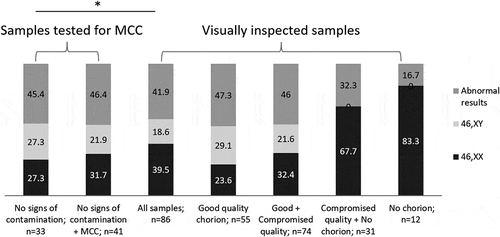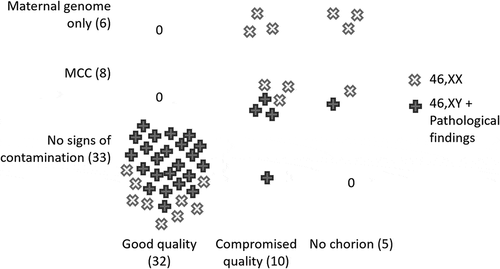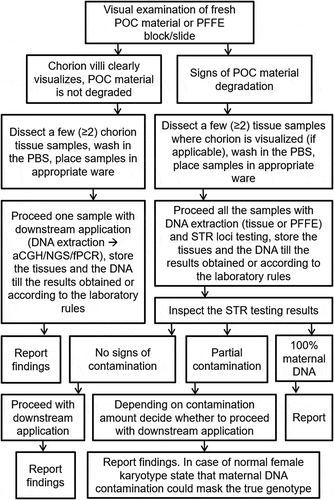Figures & data
Table 1. Chromosomal pathology distribution across positive samples (n= 36).
Figure 1. Distribution of karyotype results across different POC evaluation groups. Samples were grouped based on the MCC testing results (no signs of contamination; MCC; maternal genome only – not included in the figure since those contains only 46,XX results as expected) and visual sample evaluation (good quality chorion; compromised quality; no chorion). * Significant difference (p-value 0.02) in the observed genotypes distribution was seen between the groups ‘No signs of contamination’ and ‘All samples’. MCC – maternal cell contamination

Figure 2. Distribution of MCC-high- and -low-risk karyotypes across different product of conception evaluation groups. Y-axis depicts sample evaluation based on MCC genetic testing using STR genotyping. X-axis depicts visual examination of primary biological sample. MCC-high risk are samples corresponding to ‘46,XX’ karyotype (depicted as white X’s) can arose from analysis of fetal cells or maternal cells thus masking any genuine fetal karyotype. MCC-low risk samples are the ones showing 46,XY karyotype or any chromosomal pathology (depicted as gray crosses). MCC – maternal cell contamination

Table 2. Comparison of different methodologies used for POC analysis
Figure 3. POC handling and testing workflow. Recommendations addressing the entire workflow of POC samples handling from preanalytical, through the analytical stages suitable for molecular/molecular cytogenetic techniques. POC – product of conception. FFPE – formalin-fixed paraffin-embedded samples; PBS – phosphate buffer saline; STR – short tandem repeats; aCGH – array comparative genomic hybridization; NGS – next-generation sequencing, fPCR – fluorescent polymerase chain reaction

Table 3. Observed and expected genotype distribution when corrected for maternal cell contamination based on the approach described in Nikitina et al. Citation2005
